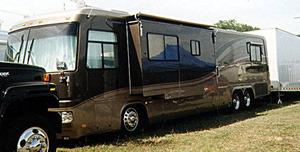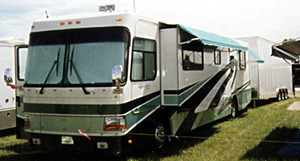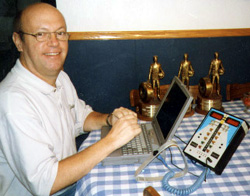Motor Home Mania and More!
 This is an article I have been trying to write for about 3 months. I wanted to get out to some National and Divisional races this summer to see the latest trends and problems. What I witnessed is not news, but when you have been racing local for a while and then go to a National Event it can shock you a little. The amount of parking space it takes to get three hundred racers in amazes me.
 When I owned Cedar Falls (Iowa) Raceway we had an NHRA Winston race and we had 365 entries in an eleven-acre pit area. It was crowded, but they all fit. I would estimate that now you would need at least twenty-five acres of LEVEL, STABLE ground to get them in. The problems don't end with acres available; it is also critical the ground be able to support 15,000- to 45,000-pound rigs. We are only talking Sportsman racers here, not professional teams. When I owned Cedar Falls (Iowa) Raceway we had an NHRA Winston race and we had 365 entries in an eleven-acre pit area. It was crowded, but they all fit. I would estimate that now you would need at least twenty-five acres of LEVEL, STABLE ground to get them in. The problems don't end with acres available; it is also critical the ground be able to support 15,000- to 45,000-pound rigs. We are only talking Sportsman racers here, not professional teams.  The motor home and trailer combinations of a few years ago that might have been called a luxury would fit the following description. A 30- to 32-foot gas powered Winnebago with a 24- to 28-foot enclosed trailer. Definitely nice to travel and stay at the track with. The motor home and trailer combinations of a few years ago that might have been called a luxury would fit the following description. A 30- to 32-foot gas powered Winnebago with a 24- to 28-foot enclosed trailer. Definitely nice to travel and stay at the track with.
What I have seen this summer has just amazed me. It is not unusual to see a diesel pusher motor home and a thirty-foot "stacker" trailer hauling in two race cars. It is also getting pretty common to see that the diesel motor homes are top of the line units with selling prices averaging $175,000 and some that sell for well over $400,000 and some tip the scales at over 25,000 pounds. The trailers behind these rigs are just as nice. They usually have a gross weight of 19,000- to 23,000-pounds when loaded. This is an awesome amount of weight to be parked in a grassy field (especially if the forecast is for rain). Can you imaging trying to tow one of these rigs out of the mud!! This is where the "new" problems for track owners begin. The rigs are getting almost out of control in size and what they require for parking. Not only space- remember, they MUST be parked on ground that won't sink under their weight. If a track wasn't originally designed for these rigs, upgrading can be nearly impossible or at the very least not affordable. Can a track justify $200,000 in paving and regrading the pit area to offer paved parking for these rigs? I think some local tracks are doing it, but I can't see that is a sound financial decision. It boils down to whether the track has the financial resources and decides to accommodate this type racer and the events they support. I have attached some photos I took recently at the IHRA National Event in Cordova, IL. Track owner, Scott Gardner, did a marvelous job redesigning the pit area over the last couple years to improve draining and ground stability. I am sitting in that pit area this morning. As we sit here in our motor home hoping the weather forecast for rain tomorrow is wrong, the view across the filled pit area is surreal. It wasn't too long ago that if you were at a race and they predicted rain you were bummed out because you couldn't race. Now the biggest fear is 'What if I get stuck with my motor home and trailer?' 'Does the track have a big enough tractor to tow me out?' 'Will it damage the motor home?' Things have NOT gotten simpler at the drag strip lately. Is it the fault of the racers or the system? Who knows? I do feel that as the majority of drag racers get older they like to have the luxuries that their personal success can offer them. With the luxuries come some problems, though. Around here the local participation has fallen dramatically over the last few years. Part of that could be because it is so much work to get these rigs ready to go every week for a one day event and also the hassles they will have parking them when they get to the local track. I feel this is one of the reasons local events have been getting smaller and multi-day events continue to grow regardless of prize money at stake. So what trends are GOOD and what trends are BAD for the sport? Nobody has that answer, yet. Time will tell and the attendance and success of events will establish the future direction drag racing will take. The IHRA and NHRA management teams probably feel that they are controlling the direction of our sport. They are WRONG if that is how they feel. The racers control the sport and its future by choosing what events they will support simply by attending those events. The next dilemma that will have a real effect on the success of racing events is the soaring price of fuel for the tow vehicles. Having been racing for nearly 30 years I know most racers will keep trying to go to the races they scheduled. The reality will be their fuel costs will have doubled from last year and that will cause a lot of racers to cut back on the number of races they attend. The well-budgeted teams will still be at all the events, but the smaller operations will be at fewer and fewer events. It is an interesting time in our sport and the future will hold a lot of surprises for all of us. I hope you can be with us as we keep an eye on the sport we all enjoy so much. Got an opinion or a different view than mine? Let's hear it! Send me an e-mail at jok@racingnetsource.com. Until then, be safe and I hope your runs will be "DEAD-ON." | Good Luck in 2000
and BE SAFE!!!!!
(We need the readers!) |  |  | | Fill out your Bracket Report Card! | 
Copyright 1999-2001, Drag Racing Online and Racing Net Source | 




